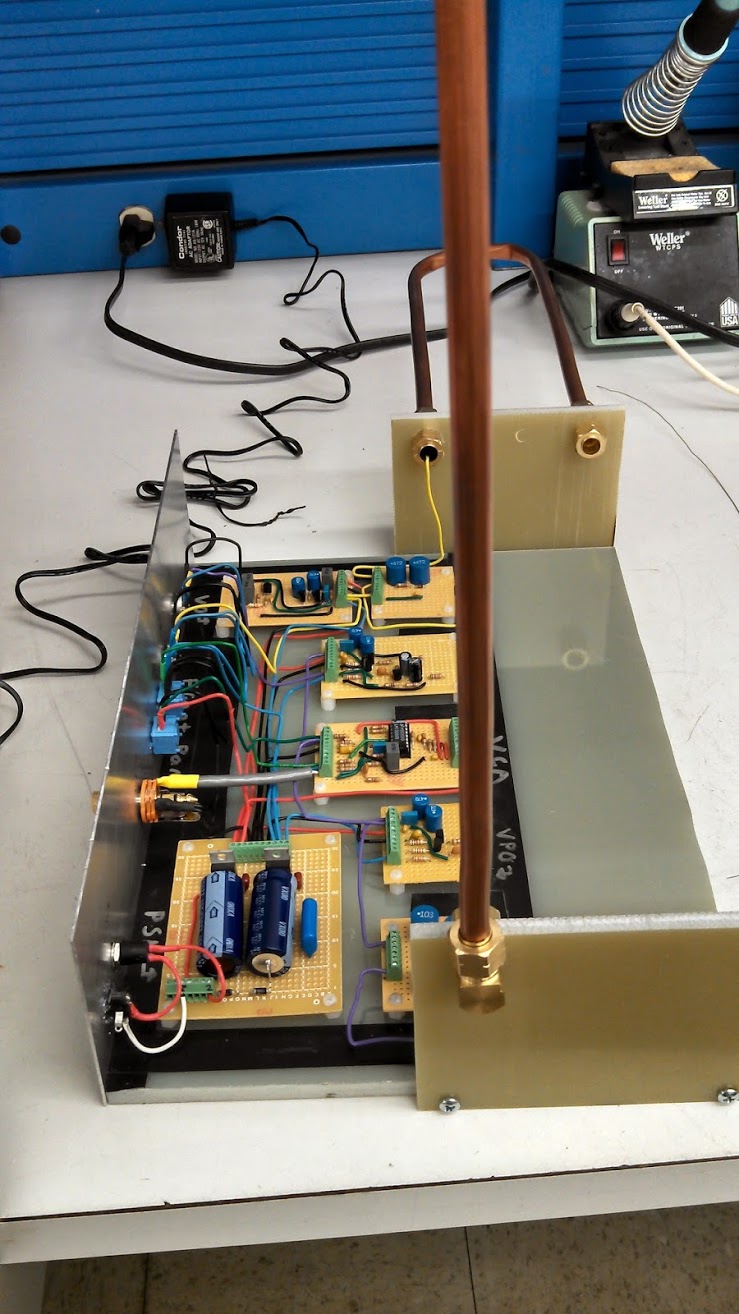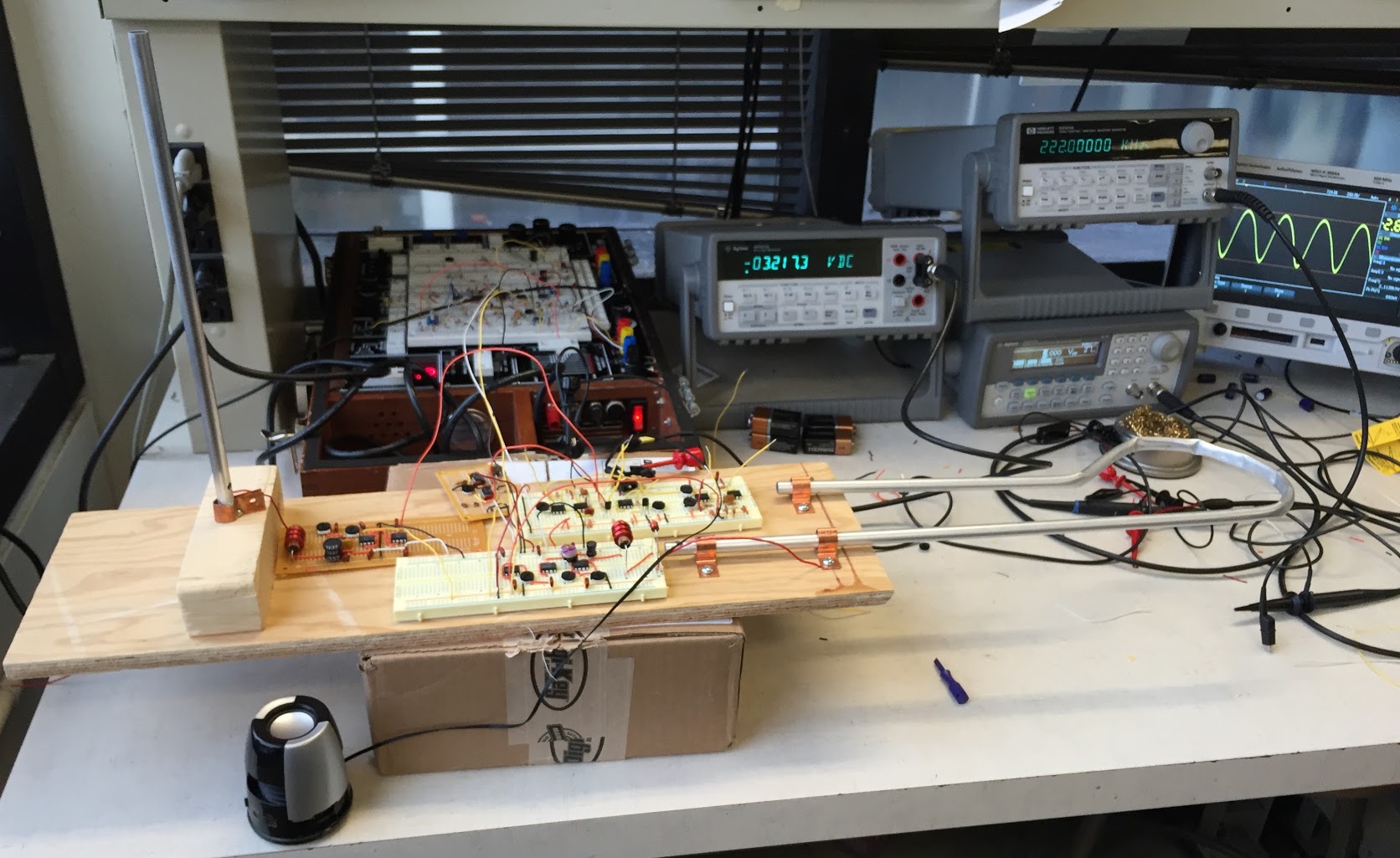Every Electrical Engineer’s, and probably also every person’s, favorite instrument should be the theremin. It’s magical, wonderful, and weird. It was invented in the 1920’s by Leon Theremin, a prolific Russian inventor.
A theremin is different from most instruments in that you never actually touch it while playing it making it fantastically suited for germaphobes. Of course as an electrical engineer, I am more interested in how it works and less so by how much hand sanitizer it might save me.
For the uninitiated, playing a theremin is “simple”. There are two antenna, a vertical antenna for pitch and a horizontal one for volume. To change either, you simply move your hand closer or farther away. The video below illuminates the concept it a bit more while also making it look fantastically easy to play this instrument, a fact that could not be farther from the truth. The theremin is probably one of the most difficult instruments on the planet to play as it requires your hands to float around in free space and land in exact positions to hit the correct notes. Maybe this, coupled with the odd sound, is a reason why this instrument has not see much use since its invention aside from old sci-fi movie scores.
After watching a video like this, most people probably chalk the operating principal of theremins up to “black magic”. In reality, a theremin depends more on changing capacitance than the dark arts.
While in use, a theremin’s antenna are electrically charged which creates an electric field around the antenna. When you move your hand towards the antenna, it interacts with this electric field and alters how much the antenna electrical charge can be stored on the antenna when it is charged with a certain voltage. This is an electrical property called capacitance.
The fact that a hand moving around the antenna can change it’s capacitance is fantastic news as there are many circuit techniques that can be employed to detect this change. The primary one used in the theremin involves what are called “LC Oscillators”. These are circuits that shift energy between a Capacitor (the antenna) and an Inductor (Another electrical component that can store energy similar to the capacitor; however, it does this with a magnetic field instead of an electrical one). As the capacitance of the oscillator changes (ie. the hand moves) the rate at which this oscillator shifts energy between the inductor and capacitor changes, in other words the frequency of oscillation changes. Frequency is a great word because another thing that has a frequency is a sound wave. So the fact that we have a circuit that can change it’s frequency as a hand moves means that all we have to do turn this frequency of electrical oscillation into a frequency of audio oscillation. Then of course if we change our hand position, thus changing the frequency of the audio oscillation we can now use our hand position to change the note that is being played. Wow!
How do we do that? The first thing to consider how much audio range we will actually be able to get. An instrument that only plays 3 notes is not very useful. To get a reasonable amount of notes our frequency will have to be able to change in a range from around 0Hz to 4kHz, in terms of musical notes this is a range from C0 all the way up to around C8, this is equivalent to the range of a piano. The problem here is that our antenna capacitance change is very small, only around 3 pico-Farads (pF) in case that means anything to you. If 3pF doesn’t mean anything to, don’t worry you are not alone. A change in capacitance of only 3pF also means nothing to an LC oscillator running at 0-4kHz, a 3pF change would barely change the frequency of such an oscillator by a Hz.
Lucky for us, if we increase the frequency of this oscillator we can actually get a sizable change in frequency from a small change in capacitance. It turns out that if our oscillator is running at around 225kHz, a 3pf change can get us close to the 0-4kHz frequency range we need. But now we have a new problem, no one can hear sounds at 225kHz. The theremin has a simple solution for this. In addition to the oscillator that varies its pitch there is also an oscillator with a fixed frequency of around 225kHz. Circuitry is then added that is able to extract the difference between the fixed oscillator frequency and the variable oscillator frequency and turn it into a new signal that varies in that 0-4kHz range. This signal is then used as the audio frequency.
What I just described is how the pitch antenna works, as you move your hand closer and farther from the antenna, the capacitance changes, which changes the frequency of the variable oscillator, which changes the difference in frequency between the fixed oscillator which finally changes the frequency of the audio signal extracted from the difference.
What about the volume antenna? This one is similar in that a change in capacitance from the antenna changes the frequency of an LC oscillator; however, things change past that because to change the volume of the audio signal a oscillation is not useful. Really what we need is a variable constant voltage, with this we can use a ‘voltage controlled attenuator’ circuit to change the intensity, and therefore volume, of our audio signal. To convert the oscillation into a changing constant voltage we take advantage of a property of the LC circuit called “resonance”. At a certain frequency, the LC oscillator will have the maximum intensity, or amplitude, of oscillation. Resonance is a common theme among things that exist, think of a wine glass that audibly vibrates when you rub it a certain speed. At resonance, the LC circuit will have a certain maximum intensity, lets say 1. If we move our hand near the antenna and change the capacitance, and then frequency of the oscillation, we move the oscillator off resonance and the intensity will reduce to something lower than 1, maybe 0.7. This is perfect because it means that if we add a circuit that extracts that maximum intensity we can now create a constant signal that directly varies with our hand position. This is exactly what the theremin does and what enables the volume antenna to work.
Hopefully I haven’t lost you at this point, but that’s a rough idea of how theremins work and probably about the limit of what I understood about how to make a theremin when I first built one my senior year of high school. I found a great article by Robert Moog, an electronic instrument pioneer, about how to build one of his EM Theremins.
EMThereminWith the help of a fantastic mentor John Goodnight, and electrical engineer who worked a PCB assembly company in Mooresville NC near where I lived at the time, I was able to create my first Theremin based off of the Moog one.

This theremin turned out pretty well and was a great experience in creating and debugging circuits. However, it still left me a bit unsatisfied, I wanted to understand more of what fundamentally makes a theremin work and learn how to design one from scratch. I eventually got a chance to do this in my Junior year at MIT. Armed with a lot more knowledge of circuits and the help of two classmates Patrick McCabe and Pedro Brito we were able to design a theremin from scratch for a class project in 6.101 an Analog Circuits class.

This theremin also worked and was a lot of fun to design. In case you like diving into the nitty gritty details, here is our paper about how exactly this theremin works and what exactly went into designing it.
6_101_Final_ProjectI think I’m still not done building theremins. The first one I build taught me how to construct one, the second taught me how to design it, but I think I will need a third to let me perfect one.
At the end of the day, a theremin is a musical instrument and must sound great and perform predictably. The theremins I build in the past sounded okay but still a bit annoying. They also suffered from some temperature instability and non-linearity in the pitch and volume changing that made them difficult to play. Hopefully one day I will get some time to really tweak the design of a theremin until it’s perfect enough that I can consider it a real instrument.

